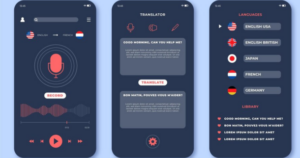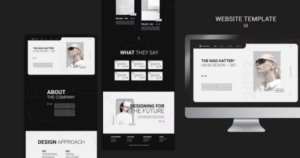
Web Design Challenges and Trends for the Future
In the quickly changing landscape of web design, staying ahead of trends and addressing common challenges is crucial for success. Whether you are a small business owner, a freelance web designer, or a marketing professional, understanding and overcoming these obstacles can significantly impact your online presence.
This blog post will explore the key challenges in web design today, emerging trends for 2024, and best practices to help you stay ahead in this dynamic field.
Key Challenges in Web Design
Complexity of Features and Functionality
One of the greatest web design challenges is managing the intricacy of features and functionality. Modern websites often require third-party integrations, like e-commerce platforms, social media feeds, and customer relationship management (CRM) systems. Balancing these elements while maintaining a seamless user experience can be daunting.
Adding numerous features can slow down site performance if not managed properly. Ensuring that each feature serves a purpose and contributes to the user’s experience is essential. Prioritising functionality can often mean making tough choices about which features to include and which to leave out.
Accessibility Concerns
Ensuring inclusivity for all users is not just a moral obligation, but also a legal one. Websites must meet accessibility standards to cater to users with disabilities. This includes providing alternative text for images, ensuring keyboard navigability, and using proper colour contrasts.
Legal and ethical considerations are becoming more prominent as regulations tighten. Non-compliance can result in lawsuits and damage to brand reputation. Incorporating accessibility from the start of the design process can save time and resources in the long run.
Performance Optimisation

Performance optimisation is crucial for retaining users. A slow-loading website can lead to high bounce rates and lost opportunities. According to Hubspot, 47% of consumers expect a web page to load in two seconds or less. Efficient coding practices, such as minimising HTTP requests and optimising images, are essential for improving site speed.
Balancing functionality with performance requires careful planning and execution. Regularly testing your website’s performance using tools like Google Page Speed Insights can help identify areas for improvement.
Responsive and Mobile-First Design
With the increasing use of mobile devices, a mobile-first design approach has become imperative. Adapting to various screen sizes ensures that users have a consistent experience, whether they are on a desktop, tablet, or smartphone. Techniques such as flexible grids, scalable images, and CSS media queries are essential for creating fluid layouts.
A responsive design not only improves user experience but also boosts SEO rankings. Google prioritises mobile-friendly websites in search results, making mobile optimisation a key factor for online visibility.
Emerging Trends in Web Design
AI and Automation in Design

AI and automation are revolutionising the web design industry. AI-generated content and layouts can significantly reduce the time and effort required for design tasks. Personalised user experiences, driven by AI algorithms, can enhance user engagement and satisfaction.
Automated design tools, such as Wix ADI and Bookmark, allow users to create professional websites with minimal effort. These tools analyse user inputs and generate customised designs, making web design more accessible to non-experts.
Dark Mode and Visual Aesthetics
Dark mode has gained popularity for its sleek appearance and energy-saving benefits. Modern web design elements, such as minimalistic layouts and bold typography, complement dark mode well. The use of dark backgrounds can reduce eye strain and enhance the visual appeal of websites.
Offering a dark mode option can improve user experience, especially for those who prefer browsing at night or in low-light environments. Implementing dark mode requires careful consideration of colour contrasts and readability to ensure accessibility.

The rise of voice commands in web navigation is transforming how users interact with websites. Voice user interfaces (VUIs) leverage technologies like Siri, Alexa, and Google Assistant to enable hands-free navigation. This trend is particularly beneficial for users with disabilities, providing an inclusive browsing experience.
Integrating VUIs into your web design can enhance accessibility and convenience. Voice search optimisation, including natural language processing (NLP) and conversational design, can improve user interaction and engagement.
Sustainability and Eco-Friendly Practices
Sustainability is becoming a significant consideration in web design. Reducing the environmental impact of websites involves optimising server usage, minimising resource consumption, and using green hosting solutions. According to Forbes, eco-friendly web design practices can contribute to a more sustainable digital ecosystem.
Green hosting providers like GreenGeeks and A2 Hosting offer eco-friendly hosting options powered by renewable energy. By choosing sustainable hosting solutions, businesses can reduce their carbon footprint and promote environmental responsibility.
Solutions and Best Practices
Simplification and Minimalism

Streamlining content and visuals through simplification and minimalism can enhance user experience. Less clutter allows users to focus on essential information and reduces cognitive overload. Prioritising simplicity in design can improve navigation and interaction.
Minimalistic designs often feature clean layouts, ample white space, and straightforward typography. This approach not only improves aesthetics but also contributes to faster loading times and better performance.
Optimising for Mobile-First Users
Mobile optimisation strategies are essential for catering to users on mobile devices. Techniques such as responsive design, touch-friendly interfaces, and fast-loading pages are crucial for delivering a seamless mobile experience. Effective mobile-first designs prioritise usability and accessibility on smaller screens.
Examples of successful mobile-first designs include Airbnb, Dropbox, and Slack. These companies have optimised their websites for mobile users, ensuring a consistent and enjoyable experience across all devices.
Accessibility and Inclusivity
Designing for users with disabilities involves following best practices and using appropriate tools. Implementing accessibility features, such as ARIA landmarks, screen reader compatibility, and focus indicators, ensures an inclusive web experience. Tools like WAVE and Axe can help identify and address accessibility issues.
Inclusive design goes beyond compliance; it fosters a sense of belonging for all users. By prioritising accessibility, businesses can reach a broader audience and demonstrate their commitment to diversity and inclusion.
Utilising Data Visualisation

Engaging users with interactive data involves using data visualisation techniques. Presenting complex information through charts, graphs, and infographics can make data more accessible and understandable. Tools like Tableau and D3.js enable the creation of interactive and visually appealing data visualisations.
Effective data visualisation enhances user engagement and decision-making. By transforming raw data into meaningful insights, businesses can communicate their message more effectively and drive user interaction.
Conclusion
Web design is an evolving field that presents both challenges and opportunities. Staying ahead of trends and addressing common challenges is essential for success. By understanding and overcoming key web design challenges, businesses can improve user experience, boost performance, and enhance accessibility.
Emerging trends, such as AI in web design, dark mode, VUIs, and sustainable practices, offer exciting opportunities for innovation. Implementing best practices, such as simplification, mobile-first design, accessibility, and data visualisation, can help businesses stay competitive in the digital scenario.
Continual learning and adaptation are crucial for future-proofing web design strategies. By staying informed and proactive, businesses can create websites that are not only visually appealing but also functional, inclusive, and sustainable.





